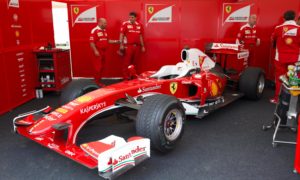Suspension
The suspension’s main job is to hold the tyres where the car’s designer of the car intended them to be. This usually means perpendicular (at ninety degrees) to the track. This permits the tyre to generate maximum grip as it’s footprint – the area in contact with the group – is as large as it can be. However, when the car is not in motion, the tyres are often not perpendicular. We shall see more about this below.
Another important job that the suspension of a racing car is to absorb the inevitable bumps in the track surface. This also plays a large role in keeping the tyres in their ideal position i.e. in contact with the road. It also makes the ride more comfortable for the driver, though in modern racing suspension settings are so hard that the travel is limited to just a few millimetres. This is mainly to optimise the aerodynamics of the vehicle than for any other reason.
The basics
There are a number of terms used to describe the motion of the car’s chassis. These are based on nautical descriptions of ships’ movement when at sea.
Heave: This is the motion of the chassis when all four wheels go up or down in unison – when the chassis goes up and down but there is no backward/forward or side to side movement
Pitch: This is when the front and rear of the chassis go in opposite directions – either up or down. However, there is no side to side movement. This oftern occurs when the car is under acceleration (the front of the car raises and the rear of the car is pushed down) and braking (the rear of the car raises and the nose dips).
Roll: This is the side to side movement of the car. This occurs when the suspension on the outer side of the car compresses as the innter suspension extends. This tends to occur whilst the car is cornering.
Warp: This is the movenemt of the diagonally opposed wheels in opposite directions eg the front right suspension compresses as the rear left extends out.
Yaw: This is the rotation of the car in the horizontal plane around a vertical axis. This usuallly occurs when the car is cornering.
Normally, these things will not happen in isolation. In reality, the movement of the suspension combines several of these things at any one time. The terms are used to combine chassis and suspension movement into their constituent parts to make it easier to understand.
There are also a number of terms to describe the location and alignment of the wheels and the hubs.
Track: This is the distance between the centrelines of the wheels. It can vary from front to back, and happens quite often.
Wheelbase: This is the distance between the front and rear axlelines. It is not supposed to be different side-to-side but can be with asymmetric cars or cars that have been damaged in accidents.
Toe-in and Toe-out: Toe-in and toe-out describes the angle of the front and rear wheels when viewed from above. When the fronts of the wheels are closer together than the rears, the pair of wheels are said to be toed-in. When the fronts of the wheels are further apart than the rears then they are toed-out. Sometimes the rear wheels are deliberately toed-in to make the car more stable under acceleration.
Camber: This is the angle of the wheel when viewed from the front or rear. Positive camber is when the tops of the wheels are further apart than the bottoms. Negative camber is the opposite and is most often used all round on a car, although it may not be the same on both the front and the rear wheels. Camber is generally the same from side-to-side on cars that have to turn in both directions. On cars that do not have to turn in both directions a great deal e.g. Indycars on the speedways, the camber can vary from side to side and this is often of benefit. Positive camber is rarely used except in the case of Indycars and sometimes one side of the car will have positive camber whilst the other has negative.
F1 Suspension
Suspension design in F1 has changed little in recent years. All teams now adopt inboard suspension operated via rockers by push or pull rods which are attached at one end to the rockers and at the other to the outboard end of the wishbone. Cars now use what is known as ‘active suspension’ which was first debuted by Lotus in 1987. This system means that the suspension arms in the car automatically move up and down ‘lifting’ the wheels over kerbs (as opposed to being devices which only move when the car hits potholes and bumps) meaning the car can maintain a more consistent ride height, which in turn means better downforce.
Front Suspension
Shock Absorbers on the top of the car’s nose absorb the bumps. These are not directly joined to the suspension arms, but are connected via push rods. The Anti-roll bar is located next to the shock absorbers. It prevents the car from tipping (‘rolling’) when the car is cornering. The Suspension Arms move up and down as the track surface undulates to try and keep the car’s height as consistent as possible.
Rear Suspension
The rear suspension must be able to handle all the traction and acceleration loads. The rear shock absorbers are mounted in a similar fashion to the front, but are placed next to the transmission.








